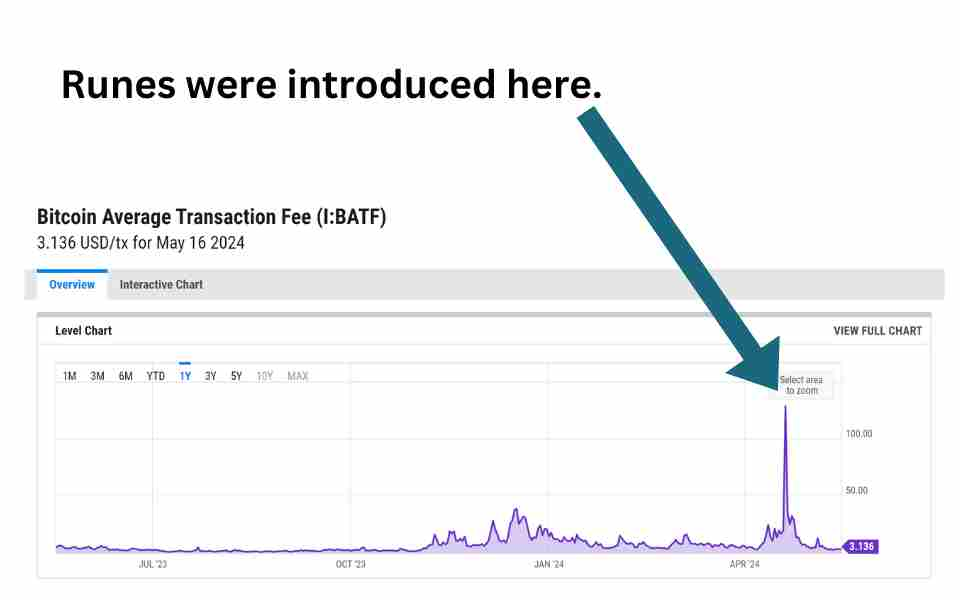Bitcoin Runes is a token standard that provides much more efficient methods to create new fungible tokens. Created by Casey Rodarmor, it was launched on the 4th Bitcoin halving day and on the 840,000th block.
- Introduction
- Who Created The Runes Protocol
- Motive for Creating Bitcoin Runes
- Terms and Definitions Associated with Bitcoin Runes
- How Does it Work?
- Bitcoin Runes vs BRC 20s
- Bitcoin Runes vs Bitcoin Ordinals
- What Does Runes Offer to the Bitcoin Ecosystem?
- Advantages over Other Protocols
- Are There Any Disadvantages?
- What’s Next for Runes?
- Conclusion
Runes employ an efficient method of creating new cryptocurrencies from unspent transaction outputs (UTXOs) which till now just went to junk.
The protocol brings great relief to developers, miners, creators and also to the entire ecosystem which has been reeling with the after effects of Bitcoin Halving. The protocol has several advantages over its predecessor and would likely see the same shining fate as of its senior cousin, the Bitcoin Ordinals.
Introduction
Bitcoin Runes is a token standard that guides developers in the creation of new cryptocurrencies. These new cryptocurrencies are created as fungible tokens and can be easily developed with a little knowledge.
The protocol was created by Casey Rodarmor who was also responsible for creating the Bitcoin Ordinals. The Ordinals protocol was key in introducing NFT-like features on the Bitcoin blockchain, something which was much greater than any expectation.
This article explores every aspect of Bitcoin Runes, be it around its benefits, improvements over predecessors, technical information, jargons and also disadvantages. At the end we have also provided a few comments on its sustainability and its future.
Who Created The Runes Protocol
The Runes Protocol was first proposed by Casey Rodarmor, who also created the famous Bitcoin Ordinals in December 2022. Casey’s proposal sought to address the problems of BRC-20 protocol which left a huge amount of junk in the form of unspent transaction outputs or UTXOs. These UTXOs were created as a result of every successful transaction.
In the Bitcoin network, transaction outputs work in a similar way as “gas” in Ethereum but in a slightly different way. Consider that you were buying something worth $4.93 with a $5 bill. Now imagine what would happen if people could only transact with notes and no one accepted coins. Obviously, the 7 cent worth of coins would go to waste.
The Bitcoin UTXOs are small quantities of Bitcoins that are used to pay for transaction fees. They are very similar to the loose 7 cents that no one accepts.
Motive for Creating Bitcoin Runes
The Bitcoin Runes were created primarily as an easy way to create memecoin-like cryptocurrencies. Upon seeing the success of memecoins in Solana (BONK, dogwifhat, and others), he was looking for a way to implement it in the Bitcoin network.
Here is a tweet from the creator himself on why he created Bitcoin Runes.
Though the BRC-20 protocol existed which creates cryptocurrencies on the Bitcoin network, yet it was a resource intensive method and left a huge signature of UTXOs much like an old car leaves a smoke trail.
Runes were a much simpler way of creating new coins. The protocol does not depend on any other protocol such as BRC-20 or Ordinals and is self-contained which means all its dependencies are already present inside it.
Terms and Definitions Associated with Bitcoin Runes
Struct
A struct or structure in the context of Bitcoin is a set of instructions that guide an activity inside the Bitcoin blockchain.
Runestone
A runestone is a message that is used to send parameters to the Bitcoin network on how the fungible token (Rune) should be created.
A runestone looks in a similar way as below.
“`rust
struct Runestone1 {
edicts: Vec<Edicts>,
etching: Option<Etching>,
mint: Option <RuneID>,
pointer: Option <u32>’
}
“`
Each Runestone is capable of transferring multiple types of fungible tokens within a single output.
Etching
Etching is the process of inscribing a transaction output with a message (runestone) that contains details of the fungible token that is to be created. The message contains details such as name, quantity, symbol, etc.
UTXO
An UTXO is a collection of satoshis (100 Mn Satoshis = 1 Bitcoin) that are used to pay for transaction fees on the Bitcoin network. When a transaction output becomes so small that it cannot be used to pay for network fee, it goes to junk. The Runes protocol is key to manage these junk UTXOs.
Cenotaphs
Those runestones which have some kind of an error are called cenotaphs. These errors may have been introduced due to bad parameters, any network clog or any other random factor.
How Does it Work?
Overview
The Runes Protocol works in a way which is known by the OP_RETURN method.
- First, with each transaction, a set of parameters are given to the Bitcoin network. This process is known as etching.
- After a successful transaction, these parameters define the output. The parameters contain information as to how the UTXOs will be converted into new fungible tokens. The process is called minting.
- The next step involves transferring a rune from a transaction input to output. This process is called an edict.
- At the end of the transaction, the user receives fungible tokens on their address.
Let us now break down the steps to understand the process in a much more detailed manner
Etching
Etching is the process of creating a Bitcoin Rune by sending token parameters to a transaction input.
The list of parameters that are sent along with a transaction output are:
- Name: The name simply refers to the name of the fungible token to be minted.
- Divisibility factor: This is the number of units a rune can be divided into.
- Symbol: This refers to the symbol of the new fungible token or tokens.
- Premine: It refers to the initial allocation of the runes that are kept for its creator.
- Terms: Refers to the rules that are to be followed by users during an open mint.
- Cap: It refers to the number of times a rune should be minted.
- Amount: This refers to the numeric quantity of the rune to be minted. A single UTXO can mint multiple fungible tokens at once.
- Start height: This is the block height where the minting of the rune starts.
- End height: This is the block height where the minting of the rune ends.
- Edict: These are messages that contain instructions on how a transaction input can be converted into an output.
Minting
Minting refers to the process of converting the unspent transaction outputs(UTXOs) into new fungible tokens. The UTXOs are converted into runes through a function called OP RETURN. This function returns the UTXOs in the form of new fungible tokens.
Transfer
The next step involves transferring a rune from input to output. These transfers are governed by edicts which are messages that are sent to describe the specifications of a rune.
Here is a sample of an edict:
“`rust
struct Edict {
id: RuneID,
amount: u128,
output: u32,
}
“`
Each runestone can create multiple types of fungible tokens with just a single input. This is a great improvement over earlier protocols where only a single type of fungible token was created at one time.
To do that, we just need to define each output with a separate edict.
For example, let’s say we have an UTXO that we wish to convert into fungible tokens. With Runes, we can not only do that but also achieve something that was impossible prior to this. For example, a single UTXO can create 1000 tokens of A type, 20 tokens of B type and 5 tokens of C type.
Bitcoin Runes vs BRC 20s
Bitcoin Runes provide several upgrades over BRC-20 protocol and these upgrades define the difference between the two.
- UTXOs are repurposed on Runes whereas they are discarded on the BRC-20 protocol.
- The fungible tokens created using Runes protocol can be transferred on Layer-2 solutions like the Lightning Network, whereas BRC-20 tokens cannot be transferred using L2s.
- Runes are based on UTXOs whereas BRC-20 tokens are based on Ordinals theory.
Suggested Reading: BRC-20 Tokens: Everything You Need To Know
Bitcoin Runes vs Bitcoin Ordinals
Runes are a protocol that uses UTXOs to create new fungible tokens. On the other hand Ordinals use satoshis to create inscriptions that lead to the creation of non-fungible assets.
What Does Runes Offer to the Bitcoin Ecosystem?
Runes offer a great benefit to the entire Bitcoin network.
Reduces Wastage of UTXOs
First, it reduces the junk that is created by UTXOs. With Runes, these UTXOs can be converted into useful tokens with a simple OP_RETURN method.
More Users and Greater Liquidity
Second, it brings more liquidity to the Bitcoin ecosystem. Due to the bullishness around memecoins, Runes would be able to bring more users and liquidity to the Bitcoin ecosystem. Just like other ecosystems, Runes have capability to drive memecoin rally into the Bitcoin ecosystem. More tokens would attract more users and hence more liquidity.
More Fees to Miners
Third, it brings more fees to the miners. More transactions would definitely generate more fees which would compensate miners in a better way. Further, after the Bitcoin Halving event, miners desperately need more fees to cover operational costs.
Suggested Reading: What is Bitcoin Halving: A Comprehensive Guide
Runes have already generated the traffic that could fulfill the needs of the miners. However, its sustainability is in question. If it goes in the Ordinal way, it would surely compensate Bitcoin miners in a sustainable way.
Advantages over Other Protocols
There are several advantages associated with the launch of the Runes protocol. Some of them are:
Improvement Over BRC-20
The main intention of creating runes was to establish a token minting process that would not be as messy as the BRC-20 protocol which left a huge trail of UTXOs after each transaction.
The Runes protocol on the other hand, managed these UTXOs in a clean way by allowing users to repurpose them as new tokens.
Works Well on Bitcoin Layer-2 Solutions
Runes work well on Layer-2 protocols such as the Lightning Network. However, BRC_20 protocols do not work in Bitcoin L2s.
Simplified Token Minting Process
With the Runes protocol, minting a new token on the Bitcoin blockchain would be at its easiest. This has already begun in great numbers. A few Runes-based tokens are:
- Satoshi Nakamoto
- The Ticker Elsa
- Wanko Manko Runes
- Meme Economics
- LOBO The Wolf Pup
Are There Any Disadvantages?
Despite all the advantages, there has been an unintended consequence of Bitcoin Ordinals. As a result of their immense popularity, just like Ordinals, Bitcoin Runes too have clogged the Bitcoin blockchain. Despite being an unintended act, this congestion has led to a spike in fees.

On April 20th, 2024, the day of launch of the Runes protocol, there was a clog in the Bitcoin network which spiked its fee to $128 per transaction as compared to its usual fee of $5 to $10 per transaction. Although the major reason for the spike was the race to transact on the 840,000th block (the halving block), yet Runes were a major contributor to the spike in the transactions.
What’s Next for Runes?
If the development of Runes continues in the future, we see a thriving ecosystem. Runes have the capability to bring DeFi to the Bitcoin blockchain, something that every Bitcoiners wants in the ecosystem. Though some rudimentary DeFi capabilities exist on Bitcoin, yet the network is far from achieving the feats of Ethereum.
Conclusion
Bitcoin Runes are a new improvement over BRC-20 protocol to create new tokens. The Runes protocol utilizes a new way to create cryptocurrencies with the Unspent Transaction Outputs (UTXOs). This method not only reduces junk UTXOs but also converts them into something useful.
The protocol is expected to bring much relief to the Bitcoin ecosystem in terms of users, miner fees and liquidity. Also, it is expected to bring much greater DeFi capabilities to the Bitcoin ecosystem, something which is much desired. Finally, we expect Runes to have a stable presence in the Bitcoin network so that it not only improves the network’s capabilities but also helps Bitcoin achieve the tag of a true market dominator.
A Guide to Bitcoin Dominance: Its Importance and Is It Declining?




















